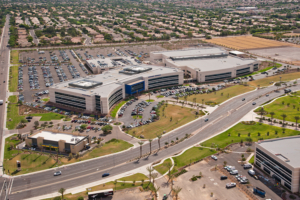Q: Have values in Metro Phoenix commercial real estate hit bottom yet?
TH: I don’t believe so in office, land and retail. I do think industrial values have bottomed out. Office is tied to job creation, which has been a train wreck here and nationally. I don’t think we have seen a sign that the job market will start picking up soon. So much of our economy is small-business based, and small business owners are sitting on the sidelines due to uncertainty in the economy. Retail is tied to consumer confidence and consumers are spending less and are far more value conscience currently. Land for commercial purposes is correlated to the unavailability of existing product and capital to develop. I believe values will continue to be soft, but well-located trophy assets will continue to see a lot of interest.
DW: I believe we are bumping along the bottom. Things are starting to stir and activity is up. I’m optimistic about 2Q of 2011 and beyond.
WS: We are bouncing around at this point. The dramatic price declines from a few months ago seemed to have leveled off, although there are some sub-markets that have issues. I still think we have a ways to go at this stage of the cycle.
Q: How have commercial foreclosures affected the markets and underlying property values?
MH: There has been a limited amount of industrial foreclosures. The anticipation of distressed industrial real estate to hit the market has clearly been greater than the number of transactions closed. The reality is that the lender is working with the borrower to solve the value problem vs. foreclosing on the property. This strategy keeps pricing higher and clearly limits opportunities for the distressed industrial asset buyer.
DW: Commercial foreclosures continue to drag the market down. They are creating the market and will continue to do so until the system has flushed.
WS: Most likely some REO sales are having an impact on values. To what extent is hard to quantify until more data shows up in the marketplace.
Q: Are you marketing your services and projects differently than in 2007?
TH: The world has become so price sensitive. Both tenants and buyers of construction services have to know that they are getting a steal to get a deal to move forward. So more than ever, you have to show great value for your services. Unfortunately, with the exception of a few top-end projects, all office and industrial projects have become a commodity. The Internet for real estate marketing has really taken off. Everyone should be using electronic marketing for their projects and services, but the trick is to make your project or firm stand out above the competition, and not be swept into the price war game.
BM: The position of the landlord and the tenant, and the buyer and the seller has reversed in the market since 2007. The prominence of the lenders, who are rapidly becoming owners, has also significantly grown during that period. All of these factors have fundamentally changed the dynamics of the marketplace, including our approach to servicing commercial real estate owners and occupiers.
DW: It is time to be a peacock. Get out all the bells and whistles. Buyers and tenants have their pick of the litter, so it is time to distinguish your project or space.
Q: What can real estate trade organizations do in this economy to survive?
MH: Survival is the key word in commercial real estate today. In order for a trade organization to survive, and then thrive when the market comes back, it must provide a product that is beneficial to its membership. A successful organization that creates opportunities for members to strengthen and create relationships is key in the commercial real estate industry.
TH: There are a variety of things we are trying currently at NAIOP-AZ. We have merged efforts with other real estate trade organizations in the fields of education and public policy. We are spreading out our range of potential corporate sponsors, attempting to pull in new-to-the-market firms and associated businesses. We are starting a leadership speaking series that will help tell our members how and where to go make money in these tough times.
JD: I think you need to have a value proposition that stands out in the crowded marketplace. NAIOP provides a unique mix of networking, educational and promotional opportunities, and additionally serves its constituents with effective lobbying at the state Capitol, which is why I continue to stay actively involved there.
Q: What new trends are coming to our local industry?
MH: The first trend that comes to mind specific to the commercial real estate brokerage industry is that we have all gone back to the basics. Whether it’s cold calling, working the database, creating a new database, and/or working longer hours … The good ol’ days are over for a while and to survive we need to work harder and smarter. Another would be a tenant demand increase for alternative energy companies. Fortunately, GPEC and our state government have promoted this new trend with legislation that makes it more attractive for the alternative energy user to locate in Arizona.
KR: The big indicator is jobs. I think we will see the U.S. incur significant job growth by 2014. Clearly, job growth will drive consumer spending, and by extension real estate as companies get back to pre-2007 hiring levels. Economic confidence will be the trend that will lead corporations to hire employees, requiring additional space.
DW: Creativity — it’s what gets things done. Nothing is straightforward in this market. The wrinkles abound.
NAIOP Roundtable 2010 Participants’ Links:
www.wwptax.com



